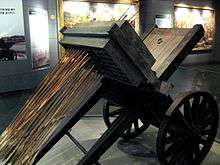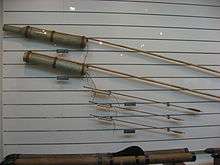Fire arrow
.jpg)
Fire arrows are an early form of gunpowder solid fuel rocket which were attached to a shaft of the arrow to provide a propulsive force. The Chinese are credited with both the invention of the fire arrow and also the first use of fire arrows in a military warfare. The Chinese developed fire arrows from their previous invention of fireworks and gunpowder.[1]
Design
_bohiya_or_bo_hiya_(fire_arrow).jpg)
The Fire Arrow was the first rocket in mechanism and design.[2] It was made in a variety of forms and launched in diverse manners, but the first design consisted of a pouch of black powder with a stick attached; the arrows were launched from a stand of bamboo sticks. Like the fins on a modern rocket, the long stick on a fire arrow increases stability and therefore accuracy. (It works by causing the center of drag to be far behind the center of mass, so that atmospheric drag keeps the arrow oriented toward its direction of travel.)
Chinese and Korean fire arrows were usually launched in salvoes from launch platforms, such as arrays of cylinders or boxes which could hold as many as 1,000 fire arrows each. The fire arrows propelled by gunpowder may have had a range of up to 1,000 feet.[3]
Fire arrows were tipped with flammable materials like pitch, bitumen, or resin.
Recorded uses
Chinese fire arrow

Fire arrows were first reported to be used by the Southern Wu in 904 during the siege of Yuzhang.[4] Wu-Ching Tsung-yoa's Complete Compendium of Military Classics which was published in 1054 said that in 994 A.D. the Chinese city of Tzu T'ung was attacked by an army of 100,000 men, the attacking army was routed by regular war machines and fire arrows.[5]
Other recorded uses were during the Jin–Song wars between the Song and Jin dynasties in:
- March 1, 1126, the Thunderbolt Thrower, used by the Song general Li Gang during the siege of Kaifeng,[6] and again in 1161 by General Yu Yunwen at the Battle of Caishi, near present-day Ma'anshan, Anhui, during a Jin maritime incursion.[7]
- 1221, the Thundercrash Bombs, used by the Jin invaders during the attack of Qizhou, which were exploding grenades filled with black powder rather than incendiary bombs filled with molten material, and lastly in 1232 when the Jin repelled the Mongolians in the battle of Kai-keng. They also used in this battle the Flying Firelances, which were bamboo tubes stuffed with black powder; the tube was ignited and used as a flamethrower.[8]
The Mongols, against whom the Chinese had primarily used the weapon, also made use of the fire arrow during their campaigns in Japan.[9] As a result of the Mongolian military campaigns the fire arrow later spread into the Middle East.[10]
Korean fire arrow

Gunpowder and knowledge of rocketry were introduced to Korea through China, and eventually evolved into the singijeon. In the late 14th century a type of fire arrow called hwajeon or hwajon were used against Japanese pirates (wokou also, kaizoku or wako) by the Korean navy.[11][12] Korean fire arrows were used against the Japanese during the invasion of Korea (1592).[13]
Japanese fire arrows
The Japanese version of the fire arrow were known as bo-hiya. Japanese pirates (wokou also, kaizoku or wako) in the 16th century were reported to have used bo hiya. Bo-hiya had the appearance of a large arrow, a burning element made from incendiary waterproof rope was wrapped around the shaft, when lit the bo-hiya was fired from a wide bore tanegashima (Japanese matchlock) or a mortar like weapon (hiya taihou). During one sea battle it was said the bo-hiya were "falling like rain".[14]
See also
References
- ↑ Rockets (Google eBook), Joseph A. Angelo. Infobase Publishing, 2006 P.1
- ↑ The History of Early Fireworks and Fire Arrows — About.com
- ↑ "History of Rocketry: Ancient times to the 17th Century". Spaceline.org. Retrieved 2013-05-31.
- ↑ 天佑初,王茂章征安仁义于润州,洎城陷,中十余创,以功迁左先锋都尉。从攻豫章,(郑)璠以所部发机「飞火」,烧龙沙门,率壮士突火先登入城,焦灼被体,以功授检校司徒。(Rough Translation: During the beginning of Tianyou Era (904-907), Zheng Fan followed Wang Maozhang under a campaign of Runzhou, which was guarded by rebel An Renyi, he was severely injured by the time it was captured, as the result he was promoted as the Junior General of Left Vanguard. At the campaign of Yuchang, he ordered his troops to propel the "flying fire" on the besieged city, after the city-gate of Longsha was burnt, he led his troops dashed over the fire and entered the city, his body was scorched, as the result he was promoted as the Prime Minister of Inspectorate.) Records of Nine Kingdoms ch. 2
- ↑ This New Ocean: The Story of the First Space Age (Google eBook), William E. Burrows, Random House Digital, Inc., Nov 5, 1999P.8
- ↑ (靖康元年二月六日)是夕,宿于咸丰门,以金人进兵门外,治攻具故。先是,蔡楙号令将士,金人近城不得辄施放,有引炮及发床子弩者,皆杖之,将士愤怒。余(李纲)既登城,令施放,有引炮自便,能中(金)贼者,厚赏。夜,发「霹雳炮」以击,(金)贼军皆惊呼。(Rough Translation: [On March 1, 1126 (Gregorian calendar)] In the evening, I slept at the gate of Xianfeng, as the Jin army arrived at the gate and nourishing their weapons. Earlier, Cai Mao had ordered the men that they were not allowed to fire on the Jin soldiers whoever came near, any firing from trebuchets and ballistas were to be caned, and the soldiers were irritate by the order. Once arrived at the walls, I had ordered them to fire, for those who could hit the enemy were to be extensively rewarded. At night, they launched the "thunderbolt pao" at the enemy, and they were all shocked.) Records of Messages from the Jingkang Era ch. 2 (author: Li Gang)
- ↑ (绍兴辛已年)我舟伏于七宝山后,令曰:「旗举则出江!」。先使一骑偃旗于山之顶,伺其半济,忽山上卓立一旗,舟师自山下河中两旁突出大江,人在舟中,踏车以行船。但见船行如飞,而不见有人,(金)虏以为纸船也。舟中忽发一「霹雳炮」,盖以纸为之,而实之以石灰、硫黄。炮自空而下落水中,硫黄得水而火作,自水跳出,其声如雷,纸裂而石灰散为烟雾,眯其人马之目,人物不相见。(Rough Translation: [Year 1161] Once our ships had hid behind the Mount Qibao, an order was given to launch out followed after the signal. Earlier, a mounted scout was sent atop the peak to watch over half cross the river, suddenly a signal was shown from the peak, and the ships came out from the river on both sides at the foot, all men on board tread as to move the ship. The ships seemed to move swiftly without sails or oars, so the savages [Jin] conceived that those were paper boats. Then, the paddle wheelers launched the "thunderbolt pao" at their enemy on a sudden, which were made of paper pots, packed with lime and sulfur. When alight, they exploded upon impact with the water, and bounce out, making a noise like thunder. The pots were cracked and lime scattered into a smoky fog, blinding and terrifying the enemy men and horses.) Collection from the Sincerity Studio ch. 44 (author: Yang Wanli)
- ↑ (正大九年)其守城之具有火砲名「震天雷」者,铁罐盛药,以火点之,砲起火发,其声如雷,闻百里外,所爇围半亩之上,火点著甲铁皆透。(蒙古)大兵又为牛皮洞,直至城下,掘城为龛,间可容人,则城上不可奈何矣。人有献策者,以铁绳悬「震天雷」者,顺城而下,至掘处火发,人与牛皮皆碎迸无迹。又「飞火枪」,注药以火发之,辄前烧十余步,人亦不敢近。(蒙古)大兵惟畏此二物云。(Rough Translation: [Year 1232] Among the weaponry at the defense city [Kaifeng] are the "thundercrash", which were made of iron pot, and filled with drugs [black powder], when lighted with fire, it exploded, making a noise like thunder. It could be heard over 100 li, and could toasted more than a third of an acre, moreover it could penetrate the armours and iron. The [Mongol] soldiers employed a siege carriage cloaked with cowskin and advance to the city below, they grubbed a niche on the city-wall, which could spare a man between. The [Jin] defenders atop did not know what to do, later an advice had offered. The pot was then dropped with an iron string from the fortress, it reached to the niche area and exploded, men and carriage were blown to pieces without trace. They also have the "flying fire-lance", which was infused with drug [black powder] and ignited it, it flames within a range of over ten paces on the front, men are not dare to near. It is say that the [Mongol] soldiers only terrify by these two objects.) History of Jin ch. 113
- ↑ The Rocket, New Cavendish books, 1978 ISBN 0-904568-10-5 P.10
- ↑ The Rocket, New Cavendish books, 1978 ISBN 0-904568-10-5 P.2
- ↑ Fifty Wonders of Korea, Volume 2, Korean Spirit and Culture Series, Authors Korean Spirit & Culture Promotion Project, Diamond Sutra Recitation Group, Publisher Korean Spirit & Culture Promotion Project, 2007, ISBN 0-9797263-4-4, ISBN 978-0-9797263-4-7 P.51-60
- ↑ Science and Technology in Korean History: Excursions, Innovations, and Issues, Jain Publishing Company, 2005, ISBN 0-89581-838-8, ISBN 978-0-89581-838-6 P.82
- ↑ Fighting techniques of the Oriental world, AD 1200-1860: equipment, combat skills, and tactics Fighting Techniques, Authors Michael E. Haskew, Christer Joregensen, Eric Niderost, Chris McNab, Publisher Macmillan, 2008, ISBN 0-312-38696-6, ISBN 978-0-312-38696-2 P.102
- ↑ Pirate of the Far East: 811-1639, Stephen Turnbull, Osprey Publishing, Nov 20, 2007 P.34
- Lu Zhen. "Alternative Twenty-Five Histories: Records of Nine Kingdoms". Jinan: Qilu Press, 2000. ISBN 7-5333-0697-X.
External links
- Great Chinese Encyclopedia - Ancient Chinese Rocket
- http://inventors.about.com/library/inventors/blrockethistory.htm
- http://neurosis.hungry.com/~ben/rocketry/firearrow.html
- http://www.spaceline.org/history/1.html
- Chinese Fire Arrows
| ||||||||||||||||||||||||||||||